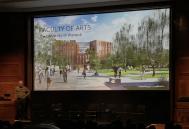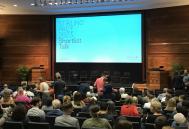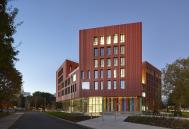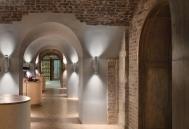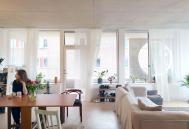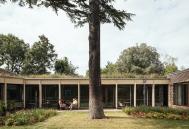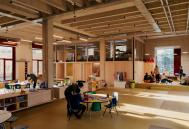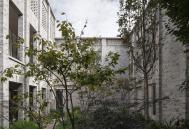Leading architects present innovative designs in response to today’s challenges
On 5th October, architectural professionals and the general public alike had the chance to learn more about the six buildings shortlisted for the 2023 Stirling Prize, described collectively by RIBA President Muyiwa Oki as “thoughtful, creative responses to today’s complex challenges.” During the packed event at the RIBA headquarters in London, each of the architects behind the selected projects gave presentations to expand on their innovative approaches to meeting and exceeding exacting design briefs. We attended the event in particular to celebrate the nomination for the University of Warwick’s Faculty of Arts building, the subject of a RIBA contest published on Tenderstream in 2016 and designed by Tenderstream member Feilden Clegg Bradley Studios (FCBStudios). We also published tenders for two of the other projects on this year's shortlist.
University of Warwick - Faculty of Arts
Keith Bradley, FCBStudios founding partner, revealed how the ambitious faculty development was intended to provide an exemplary place for arts education, at a time when the value of studying creative pursuits is often questioned. As well as providing educational spaces varying from secluded areas for scholarship all the way through to performance studios, the building also had to serve as a cultural destination for the wider campus and beyond. The central design idea of uniting these disparate functions was inspired by the trees on the surrounding parkland site, resulting in an ergonomic structure in which four pavilion buildings are connected together by a lightweight atrium and a timber staircase. At the end of the presentation, a film of the new facility with a narrated poem by Raymond Antrobus – the text of which features on a wall of the faculty - demonstrated how the form of the building itself reflects, promotes, and fosters the artistic activities taking place inside it.
Courtauld Connects - The Courtauld Institute of Art
Stephen Witherford, director at Witherford Watson Mann Architects, described the contrasting challenges facing another project in the creative realm, the transformation of the Courtauld Institute of Art. The tender – published in Tendertream in 2013 – called for comprehensive repair and conservation work, alongside the creation of new spaces. Stephen explained how the necessarily subtle interventions on the Grade I-listed site mask the project’s wider success in contributing to an ambitious ‘change of culture’ for the institution, uniting formerly scattered and separated functions to establish a fully networked and accessible academy.
A House for Artists
On the artistic theme once more, but this time in the residential sector, co-founder of east London practice APPARATA, Astrid Smitham, spoke about the House for Artists in Barking town centre. Completed in 2016, the building provides twelve live/work spaces for creative people, while also serving as a wider model for affordable and sustainable housing. In exchange for reduced rent, the artists deliver free creative programmes for the surrounding neighbourhood. Astrid revealed how the design – which includes features such as openable walls between some units – offers flexibility that allows residents to take ownership of the space.
John Morden Centre
An improved quality of life was also high on the agenda in the design criteria for John Morden Centre at John Morden College, Blackheath, a charity dedicated to providing homes for older people in need. Alex Ely, founder of Mae, expanded on the elegant concept for a modern, open version of a cloister that complements the adjacent building, which is attributed to Wren. In order to provide spaces for both health and recreation – including a medical centre, consultation rooms, art space, theatre, offices, and a café - a timber ‘spine’ meanders through a series of brick pavilions, transforming the former car park on a constrained site into a welcoming communal building that encourages interaction and engagement.
Central Somers Town Community Facilities & Housing
Adam Khan, founding director of Adam Khan Architects, described a project that provides space for much younger users. Central Somers Town Facilities and Housing includes a flexible community children’s facility and several housing units for social rent. As part of a masterplan commission by the London Borough of Camden - with the tender published by Tenderstream in 2014 - the project’s open nature allowed the architects to change plans based on ideas from its future participants, with the children expressing the need for their facility to be more central, and planners changing its location in response.
Lavender Hill Courtyard Housing
The Lavender Hill Courtyard Housing project by Sergison Bates involved the redevelopment of a sheet metal workshop into nine apartments, arranged around a central courtyard garden. Stephen Bates’ presentation took the form of a virtual tour through the development, describing the journey from a dense urban outside space into a welcoming inner world, with communal areas balanced by private amenities. The design showed the potential for a brownfield site in a developed area to become a comfortable, peaceful living space.
Effective responses to design challenges
Although not particularly varied in their locations across the country, with only one project outside London, the presentations nevertheless demonstrated how the designs behind the shortlisted buildings provided effective responses to diverse briefs. Whether combating isolation in the elderly or providing safe spaces for children, transforming historic institutions or creating entirely new ones, providing affordable living space or densifying already built-up areas, the evening was a welcome chance to hear more about the creative inspiration and practical work necessary to tackle societal challenges through effective design.
Lucy Nordberg
Tenderstream Head of Research
Tenderstream business intelligence service brings you the very latest project opportunities from around the globe. It is currently the only project leads service available that is both entirely global and specific to architecture. Start your free trial here or email our team directly at customerservices@tenderstream.com








